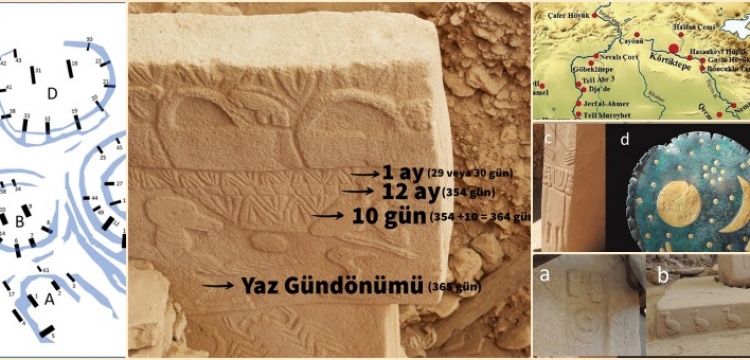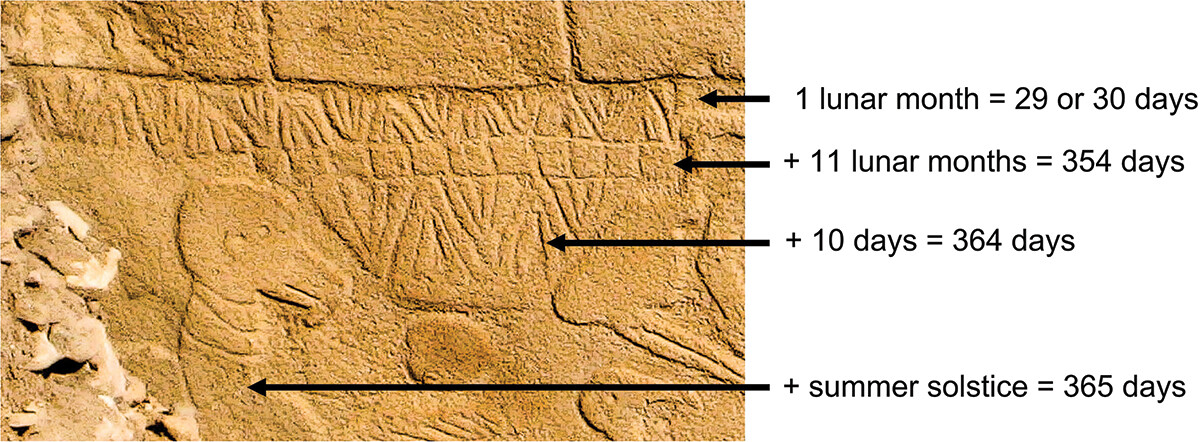A mystery has been solved in Göbeklitepe: The T-shaped stone with vultures is a calendar or astronomical record

A series of carving on stone pillars at skein of archaeological secrets Göbeklitepe could be an astronomical record of an event that triggered a key shift in human civilisation.

Detail of the centre of Pillar 43 at Göbekli Tepe.
According to a recent study from the University of Edinburgh, the markings at the location might be a record of an astronomical event that marked a significant turning point in human civilization.
"Representations of calendars and time at Göbekli Tepe and Karahan Tepe support an astronomical interpretation of their symbolism" article at Time and Mind, published signed by Martin B. Sweatman. July 24, 2024... (for more: doi: 10.1080/1751696X.2024.2373876)
According to news of sci.news; According to news of sci.news; In a new analysis of V-shaped symbols carved onto pillars at Göbekli Tepe (‘Potbelly Hill’ in Turkish) , Dr. Sweatman found that each V could represent a single day.
This interpretation allowed the researcher to count a solar calendar of 365 days on one of the pillars, consisting of 12 lunar months plus 11 extra days.
The summer solstice appears as a separate, special day, represented by a V worn around the neck of a bird-like beast thought to represent the summer solstice constellation at the time.
Other statues nearby, possibly representing deities, have been found with similar V-markings at their necks.
Since both the Moon’s and the Sun’s cycles are depicted, the carvings could represent the world’s earliest so-called lunisolar calendar, based on the phases of the Moon and the position of the Sun — pre-dating other known calendars of this type by many millennia.
“Ancient people may have created these carvings at Göbekli Tepe to record the date a swarm of comet fragments hit Earth nearly 13,000 years ago, or 10,850 BCE,” the scientist said.
Figure 1. Left: Plan of Enclosures A–D at Göbekli Tepe. Right: Pillar 43 at Göbekli Tepe, Enclosure D. Image courtesy of Alistair Coombs.
“The comet strike is suggested to have ushered in a mini ice age lasting over 1,200 years, wiping out many species of large animals.”
It could also have triggered changes in lifestyle and agriculture thought to be linked to the birth of civilization soon afterwards in the Fertile Crescent of West Asia.”
Figure 2. (a) Selection of archaeological sites around Göbekli Tepe in upper Mesopotamia (from Siddiq et al. Citation2021). (b) Selection of contemporaneous sites around Göbekli Tepe and the Harran plain (from Ayaz Citation2023).
Another pillar at the site appears to picture the Taurid meteor stream — which is thought to be the source of the comet fragments — lasting 27 days and emanating from the directions of Aquarius and Pisces.
The find also appears to confirm that ancient people were able to record dates using precession — the wobble in Earth’s axis which affects the movement of constellations across the sky — at least 10,000 years before the phenomenon was documented by Hipparchus of Ancient Greece in 150 BCE.
The carvings appear to have remained important to the people of Göbekli Tepe for millennia, suggesting the impact event may have triggered a new cult or religion that influenced the development of civilization.
The find also supports a theory that Earth faces increased comet strikes as its orbit crosses the path of circling comet fragments, which we normally experience as meteor streams.
Figure 3. (a) Likely moon and sun symbols below an ‘H-symbol’ underneath the ‘head’ of Pillar 18. (b) Seven birds possibly symbolizing the Pleiades on the base of Pillar 18. (c) Belt buckle and fox-pelt loincloth, both reminiscent of a comet, on the narrow, inner face of Pillar 18. (d) The Nebra sky-disc, displaying symbols for the sun, moon, Pleiades and, possibly, a comet (image from Wikipedia, CC-by-4.0). Images a, b and c courtesy of Alistair Coombs.
“It appears the inhabitants of Göbekli Tepe were keen observers of the sky, which is to be expected given their world had been devastated by a comet strike,” Dr. Sweatman said.
“This event might have triggered civilization by initiating a new religion and by motivating developments in agriculture to cope with the cold climate.”
“Possibly, their attempts to record what they saw are the first steps towards the development of writing millennia later.”
